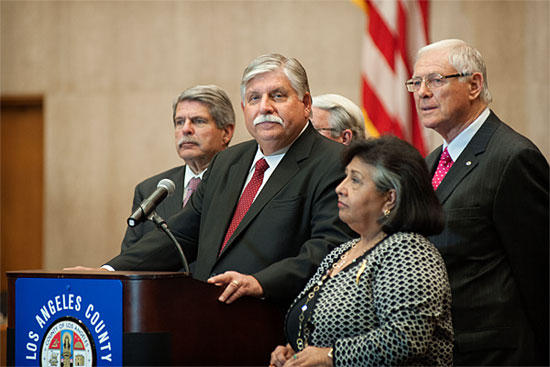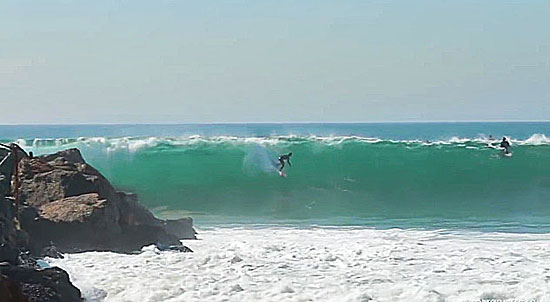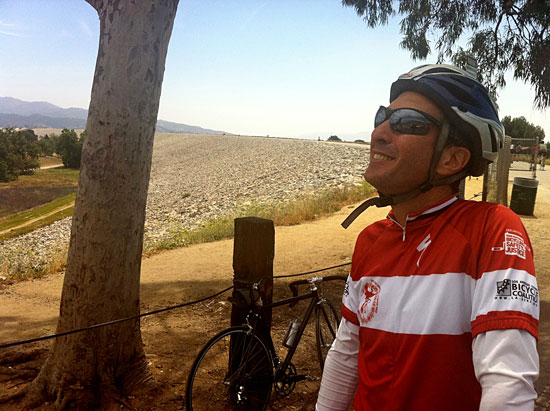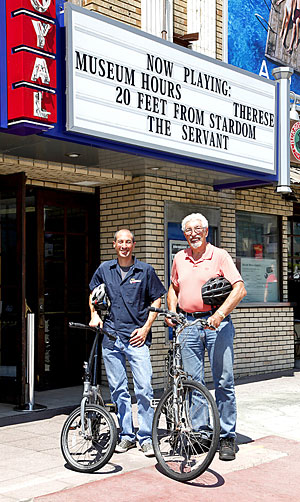Some straight talk from new sheriff
January 29, 2014

Interim Los Angeles County Sheriff John Scott (center) is flanked by supervisors as he meets the press.
After 36 years on the Los Angeles County Sheriff’s Department—with jobs ranging from street patrol in Lakewood to overseeing the country’s largest jail system—John Scott did not like what he was seeing.
“I thought the direction of the department was taking a turn that I did not want to be part of,” Scott recalled. “I saw diminished accountability. I saw fragmentation within the department. I saw some people who did not represent the best interests of the department.”
Scott said he felt “an obligation to talk to the sheriff.” But after voicing his concerns, he said he did not believe he had the support he needed “to fight the good fight.” So in March of 2005, he retired.
But on Tuesday afternoon, nearly nine years later, he was back, standing before a bank of TV cameras in the downtown Hall of Administration. He was flanked by members of the Board of Supervisors, who had just selected him as the department’s interim sheriff. His mandate: to keep the troubled agency moving swiftly toward reform until the election of a new sheriff either in the June primary or November runoff.
Scott will replace Sheriff Lee Baca, who officially retires on Thursday at noon. Baca’s departure comes after more than two years of steady controversy that eroded the agency’s reputation, including the recent indictments of 18 current and former members of the department for alleged brutality in the jails and obstruction of justice.
With no incumbent on the ballot, the race to succeed Baca has turned into one of the most heavily contested in the department’s recent history. At the same time, Baca’s unexpected retirement put enormous pressure on the Board of Supervisors to find an interim sheriff who would aggressivelyimplement reforms recommended in 2012 by the blue-ribbon Citizen’s Commission on Jail Violence. “We didn’t want a caretaker,” said Supervisor Zev Yaroslavsky. “And we didn’t want someone distracted by campaigning for the job.”
Scott seemed to be a good fit on both counts.
Besides his years of service in Los Angeles, Scott has spent the past 5 years as the undersheriff in Orange County. There, he has helped the agency recover from a sensational corruption scandal involving ex-Sheriff Michael Carona, who ended up in federal prison for witness tampering. Scott was recruited by Carona’s successor, Sandra Hutchens, a former division chief in the Los Angeles County Sheriff’s Department. (Scott, who is taking a leave of absence from his Orange County post, will return there after Baca’s replacement is sworn in.)
In an interview Wednesday with a writer for Supervisor Yaroslavsky’s website, Scott said his first—and top—priority will be to make sure everyone on the command staff is “in alignment” with the mission of bringing substantive reform and accountability to the department so they can effectively communicate it throughout the organization.
“I need to know that I have their complete buy-in,” he said. “If I don’t, then there’s going to be changes. I’m not bashful about that.”
Scott said he’s optimistic that changes in policy and direction can come quickly. But he said he’s realistic about the deeper cultural changes. “That’s a time-tested kind of process,” he said. “It’s like turning that big aircraft carrier.”
In Orange County, he said, some members of the department who resisted change ended up leaving the department because “it was heading down a different path—not one they chose. What you’re left with are people who have bought in.” He said he suspects the same thing could happen in Los Angeles.
For help in his new job, Scott has turned to a former colleague, retired Field Operations Chief Neal Tyler, who’ll return as an executive officer.
“I need immediate assistance from someone I know and trust,” Scott said of Tyler, who oversaw operations in Malibu/Lost Hills, Crescenta Valley, Altadena and Lancaster, among other places. Scott said that Tyler, like him, “had a great deal of difficulty with things that were going on.” Tyler left the department about a year ago, Scott said.
Scott said one of the challenges they’ll face is keeping the political race for sheriff from creating divisions and distractions in the rank and file. The current field includes two high-ranking insiders, as well as two former members of the department who’ve maintained alliances on the force. He said he will make it clear to the two inside candidates that “the operation of the Sheriff’s Department is Priority One and that their campaigns are on their own time…The mission is what we need to focus on, not the candidates. We need to keep this ship righted.”
On a personal level, Scott said his wife, Alice, strongly supports his return to the department so he can finally press ahead with the reforms he wanted to initiate before he felt compelled to leave. She’s a former sheriff’s captain, who retired in 2010, and, like him, did not like what she saw.
“She is one of those who watched internally and then from a distance and felt very disappointed and frustrated,” Scott said, adding: “I want to bring back the department’s premiere status.”
Posted 1/30/14
Scratching a $33,413-a-month itch
January 29, 2014
We all have our baggage. Take the 70,000-plus dogs and cats that arrive each year at Los Angeles County’s animal shelters. Think they come alone? Think again.
“Ohhhhh,” laughs John Gonzales, a former animal control officer who is now president of the nonprofit Los Angeles County Animal Care Foundation. “Ticks and fleas.”
“All it takes is for one dog to show up with a couple and within 20 minutes they all have them,” says Gonzales, whose organization supports the county shelters through fundraising for spay-and-neuter programs, pet adoptions and other animal welfare initiatives.
“And then if you adopt the animal out, even if you give him a quick bath, people will come back complaining that not only does their new pet have fleas, but their whole house is infested. It’s not a pleasant situation. And that’s not including what the poor animal goes through.”
That scenario used to play out with dispiriting frequency at county shelters, where intake workers rarely had the time or budget to do more than spritz flea spray onto the itchier-looking arrivals, and where managers periodically had to call pest control companies in to treat the kennels.
“The ticks were especially hard to get rid of,” says Animal Care and Control Director Marcia Mayeda, ”because they can jump off the animals and hide, even in the crevices of broken concrete.”
For the past three years, however, the county has been deploying a secret weapon, donated through the Foundation from a pet products manufacturer.
“Now, when animals are brought in, they get a physical, vaccinations and a spot treatment of flea medication,” says Mayeda, crediting a $33,413-per-month, in-kind gift of Frontline Plus by the Georgia-based Merial Corp.
“We still obviously clean and disinfect our kennels daily but we no longer have to bring in people to treat them for ticks and fleas.”
The product donation, which is not unusual between manufacturers and pet advocacy organizations, is part of Merial’s “Partners in Protection” community outreach program to shelters and veterinarians.
Nikkia Starks, director of consumer marketing at Merial, says the program has connected with more than 50 shelter clinics across the country to help protect pets from fleas, ticks and heartworm disease while educating shelter staff and pet owners on the importance of preventative pet health care. The Los Angeles County gift, she adds, is among its larger ones.
Though some municipalities have agreed to tout Merial’s products in return for their donations, the county’s use of the product carries no such conditions. Rather, Gonzales says, Merial donates supplies of Frontline Plus to the Foundation, which then passes it on to the county’s seven animal shelters. “We’re kind of the middle man,” he says.
The foundation’s nonprofit status, he adds, offers the manufacturer a tax break without obligating the county to serve as a marketing partner. Mayeda says Merial approached the county in 2011 with the offer. Recognizing the brand, she in turn took it to Gonzales, she says.
Such spot treatments—so called because the pesticide is applied on a spot of skin at the back of the animal’s neck so the pet can’t accidentally ingest it—typically keep pets flea-free for up to 30 days at a time, but tend to be pricey. Frontline Plus, for instance, retails in pet stores for up to $18 per dose.
“We never used it before because we couldn’t afford it,” says Mayeda. “But our flea and tick problem has gone from an ongoing concern to pretty much nonexistent, and it has made a big difference in the overall health of the animals, and in customer service as well.”
Posted 1/23/14
The state of the shark
January 29, 2014
Last July at the end of a long beach day, a Los Angeles County Sheriff’s helicopter spotted a 6-foot-long great white shark off of El Porto Beach. The copter’s loudspeaker was so clear that some South Bay locals heard it at home in their kitchens: Exit the water immediately.
To authorities in the air, it made perfect sense to issue a warning. Down on the sand, however, the sighting was familiar to county lifeguards—a baby great white feeding on small fish and stingrays, off the coast of a county that hasn’t seen even a hint of shark trouble in 25 years.
More broadly, however, the incident underscored the recent rise in local shark encounters, and the lack of a clear, uniform local policy on how to handle them. That’s why the Los Angeles County Fire Department’s Lifeguard Division will be hosting a symposium at Dockweiler Beach on Friday for local public safety personnel, elected officials and researchers. Organizers say the event is intended partly to work toward a policy consensus and partly as an opportunity to examine the state of the great white shark on beaches here.
“To my knowledge, no one has ever been fatally bitten by a great white in Los Angeles County,” says Chris Lowe, a marine biologist who leads the Shark Lab research center at Cal State Long Beach. (A suspected 1989 attack off the coast of Malibu was handled by Ventura County and never confirmed.)
“But the sightings have gone up, and the numbers seem to be going up, too,” Lowe says. “So this is partly to bring water safety people up to speed.”
Great whites are the best known of about ten shark species that can be found off the Southern California coastline, Lowe says, but they generally prefer habitats that are rockier and colder. Female sharks are believed to migrate to this area to give birth to their offspring, which may be why the sharks that seasonally show up in our waters tend to be juveniles under 12 feet, Lowe says.
Because great whites are hard to tag, he says, their numbers are hard to pin down.
“But their populations do seem to be increasing,” he says. Theories range from cleaner water and recovering fisheries to the fact that, as a candidate species under the state Endangered Species Act, great whites are protected in California, so it is illegal to catch and kill them.
That, however, hasn’t kept thrill-seekers and shutterbugs from seeking them out in numbers sufficient to prompt another theory—that there aren’t necessarily more great whites in the water, just more cameras.
Last year, a bumper crop of SoCal shark encounters showed up on YouTube, from a viral helmet-cam clip of a young great white swimming under an audibly nervous paddleboarder to footage of a surf fisherman reeling in a 3-year-old great white near San Onofre.
“You have to be prudent,” Lowe says. “Even though most of those sharks off Manhattan Beach were babies, if someone chases and corners them, they’ll do what any animal would if it feels threatened—it will attack you. It’s generally not a good idea to chase a shark around.”
Though the few shark attacks that have occurred south of Point Conception have been in other counties, Lowe says that he can understand the desire for local consensus on policy.
“In Hawaii, for instance, we trained lifeguards and helped them develop procedures based on things like the size of the shark, whether it appears to be aggressive and whether there have been indications that people or animals have actually been bitten,” he says.
“So at this symposium, we’ll be talking about what can be done, whether to close the beaches or post notices or just pass the word to other lifeguards. And some areas may already have some of those policies in place.”
Dan Murphy, ocean lifeguard specialist for the Los Angeles County Fire Department’s Lifeguard Division, notes that local beaches fall into a variety of jurisdictions. Most are guarded by the county, but some have state or local personnel guarding the waves.
In years past, lifeguards say, the lack of a single local policy on great whites hasn’t mattered much because so few attacks happened. Baby great whites, they say, have been known to cruise right under a surfer and pose no danger.
“But that’s not to say that one of those might not take a left turn one day and chomp a stand-up paddler,” says Lifeguard Capt. Kyle Daniels, who notes that San Diego has a well-developed response policy for shark sightings. “Outside Santa Monica Bay, I’ve seen sharks eating sea lions—not at highly populated beaches, but still.”
Tom Ford, director of marine programs at the Santa Monica Bay Restoration Commission, says it is important for coastal stakeholders to educate each other as they learn more about co-existing with an important predator.
“This isn’t some scene out of ‘Jaws,’ ” he said. “These animals are part of a healthy environment and we want them to go through the course of their day without any harm to their natural movement.”
Posted 1/15/14
Surf’s up—and rescues, too
January 29, 2014
Bone-crushing waves in Palos Verdes. Lookie-loos being washed off the rocks in Abalone Cove. Kids getting caught two and three at a time in rip tides.
It’s been a gnarly winter on Southern California’s coastline so far.
Faced with a triple threat of unusually warm weather, long holiday weekends and, most recently, high surf advisories, Los Angeles County lifeguards have been hustling to keep up with a decidedly unseasonal spike in attendance at the beach.
“I’ve been a lifeguard since 1986,” marvels Los Angeles County Lifeguard Capt. Tim Arnold, “and this is by far the busiest December and January I’ve had in my career.”
January attendance at county beaches is almost twice what it was last year, with nearly triple the number of rescues, lifeguard figures show. Spurred by heat waves that have sent temperatures into the 90s in some parts of Southern California, beach-goers have hit the sand more than 2.6 million times this month, and lifeguards have had to make more than 111 rescues.
That’s not counting the thousands of people who have had to be warned away from dangerous water, or the hundreds who have gotten into enough trouble to require medical attention. And January isn’t over yet.
“This year’s Martin Luther King holiday was probably the biggest winter day I’ve ever seen in my life,” says Arnold. “Between Manhattan Beach and Hermosa Beach, we had, like, 20 rescues.”
Complicating the job has been a swell produced by a storm system over the central Pacific that has been generating 10- and 12-foot waves along parts of coastal Southern California. South Bay beaches have been hardest hit, but county lifeguards also have felt it in Santa Monica and Malibu.
“It’s been tough for the guys sitting on the towers,” says Lifeguard Capt. Tim McNulty, who works the beaches from Big Rock in Malibu to Nicholas Canyon. At Zuma Beach, he said, only five of eight stations could be manned on MLK weekend because so many people on the “recurrent” list of part-time seasonal lifeguards were away at winter jobs or college.
“Everyone was on the edge of their seat with this surf and all those people,” says McNulty. “And we had hired everyone who was available on the recurrent list. We were calling people out of the blue.”
Lifeguards say rescues have been routine in nature, but summer-like in volume, with an inordinate number of novice surfers in over their heads.
“A lot of them are people on these boards called Wavestorms, that they sell at Costco for like $100,” says Arnold. “They’re like soft surfboards, and they essentially put a board into the hands of anyone who wants one, and these people are coming down and getting caught in situations they shouldn’t get caught in.”
Lifeguard Capt. Chris Linkletter, who also works in the South Bay, says daredevils and curiosity seekers have also been a problem.
“We had a surfer who broke his leg at the bottom of the Palos Verdes cliffs this week, and two people who were washed off the rocks in Abalone Cove,” she says. “We had some ‘blitzes’, too, where two or more people have to be rescued, usually from rip currents. Everybody’s seeing the high surf advisory on the Weather Channel and we’re having a lot more people who want to come out and take a look.”
Linkletter says she’s been advising all who will listen to remember a few basic safety tips for visiting the beach.
“Don’t swim alone,” she says. “Stay near an open lifeguard station. Keep a safe distance from piers and rocks, and obey the signs and warnings. And always check with the lifeguard to make sure conditions are safe.”
Lifeguards say they’re hoping for some relief this weekend, when Super Bowl parties are likely to keep at least some people at home.
“Other than that, I’m just waiting for rain,” says Arnold. “Though we don’t seem to get any of that anymore.”
Posted 1/29/14
Record numbers riding easy on Expo
January 29, 2014
The first phase of the Expo Line is getting up to speed—six years ahead of schedule.
Metro had projected the line would be carrying 27,000 riders a day by 2020. It has been surpassing that mark since last fall. In December, an average of 27,360 rode it every weekday.
And, in a win-win for passengers and the transit agency, the line’s success hasn’t translated to overcrowded train cars, at least so far.
Tiffany Laurence, 24, uses Expo to commute from downtown Los Angeles to Culver City. She said that seats are plentiful, even during the morning and evening rush.
“Those are the only times I have someone sitting next to me,” Laurence said. “Normally, I have a whole row to myself—it’s so luxurious.”
Bruce Shelburne, Metro’s rail operations chief, is also glad for the extra room. He said the line will need the seating capacity when the second phase to Santa Monica opens in 2015. Shelburne expects that to draw flocks of commuters and tourists, even on the weekends. “We’re not breathing hard and we’re at 27,000,” he said. “If we were at 40,000 I’d be awfully nervous.”
For now, the extra room offers easygoing rides to people like Jerry Davis, a Houston, Texas, city councilmember who was in town on business on a recent Wednesday.
“The only lines we’ve seen have been the traffic lines, so it makes us want to come to the rail,” Davis said. “It’s a nice, sunny day—we’re putting less emissions into the air and saving the environment.”
Samantha Bricker, Chief Operating Officer for the Exposition Rail Authority, said much of the ridership comes from the numerous entertainment venues and institutions that are along the way, like Staples Center and the University of Southern California. She also said the line draws a lot of people from the Westside. A 600-space park-and-ride lot at the Culver City station—the furthest west spot on the Expo Line so far—regularly fills to capacity in the morning.
Aside from getting people from Point A to Point B, Expo also seems to be changing how they live. Sandip Chakrabarti, a Ph.D. candidate in urban planning at USC, has been studying how the Expo Line has affected the way people who live in the area get around. “There is evidence that it has altered travel behavior quite a bit,” he said. “People near Expo stations have been driving a lot less.” On a personal note, he said that when the line starting running it enabled him to move from an area near the school to Culver City, which he prefers.
For commuters like Peyton McElyea, who takes the rail to his real estate job in downtown Los Angeles, a major part of driving less is being able to use travel time more productively.
“You can read the Wall Street Journal, the morning paper, you can respond to email,” said McElyea. “You know you have that 30-minute block where you can get something done. It’s better than being there with your hands on the wheel.”
Metro’s Shelburne said McElyea’s perspective is not uncommon; rail transit is generally becoming more popular across the board.
“The train’s sexy, that’s the bottom line,” Shelburne said. And the unpredictable traffic on the frequently-gridlocked 10 Freeway doesn’t hurt that appeal. “The train is dependable. It’s going to be that way every day.”
Posted 1/21/14
Cycling’s marquee player
January 29, 2014
A “Super Bowl Sunday Funday Warm-Up Ride” offers a healthy diversion before the coming onslaught of game day nachos, truck ads and football.
Next month, a benefit screening of the 1979 feel-good cycling flick “Breaking Away” gives a boost to “Operation Firefly,” a program of the Los Angeles County Bicycle Coalition (LACBC) that provides bike lights to folks who need them to ride safely at night.
And in April, “Climate Ride California” spins through the northern part of the state, raising funds for non-profit environmental and alternative transportation organizations, including the LACBC, which is sending a team.
A common denominator in all three events? Greg Laemmle, president of the 75-year-old local theater chain and an increasingly visible advocate for bicycling in Los Angeles.
These days, in fact, it’s hard to miss him: he’ll be the guy leading that Super Bowl Sunday ride from the North Hollywood Red Line station to Griffith Park and back. (He did it last Super Bowl Sunday, too, with an L.A. football history-themed itinerary stretching from the Coliseum to the Rose Bowl.)
He’ll also be at the “Breaking Away” fundraiser, which takes place Feb. 12 at Laemmle’s NoHo 7. And he’s captaining the LACBC’s team for the Climate Ride, which is being promoted with a “Ride with Greg Laemmle Contest” featuring movie pass prizes and contributions toward riders’ fundraising goals.
In other words, he may be an off-screen player in the movie biz, but in the local cycling world, he’s an above-the-line star.
“He’s a great face for our cause and the set of causes he supports,” said LACBC executive director Jennifer Klausner, noting that the Laemmle name is “synonymous with Los Angeles,” especially among art film devotees.
“We feed on the passion that he has for a wonderful future vision of a liveable Los Angeles,” Klausner said.
Although Laemmle, 48, has early memories of riding his bicycle at the beach and to Franklin Elementary School in Santa Monica, it wasn’t until gas prices spiked in 2007 that he felt moved to take things to the next level. He became a bicycle commuter between his home in Century City and his company’s office over the Royal Theater in West L.A.
Since that time, he has joined the LACBC board and become something of a two-wheeling role model, hoping to persuade fellow Angelenos to give cycling a try, particularly for the most common trips of three miles or less.
Beyond his daily bike commute, Laemmle and his wife, Tish, a top fundraiser for the popular annual River Ride, bicycle all over town.
“It’s crazy to get to the Hollywood Bowl by car, and sometimes it’s a lot of fun to ride your bike there,” Laemmle said. “I ride to Dodger Stadium and, to their credit, the Dodgers have added bike parking. We rode downtown to see a play yesterday at the Ahmanson.”
The couple ended up taking the Expo Line home from that one—making it a “multi-modal” outing involving both bikes and light rail.
“As Metro expands, the opportunity to combine Metro transit with bicycling really opens up a lot of possibilities for getting around,” Laemmle said.
He acknowledges that there are dangers out there for cyclists interacting with cars on L.A. streets, although he said he hasn’t personally experienced any mishaps.
“I have almost never encountered a situation where a driver is aggressively acting in a dangerous manner,” Laemmle said. “For the most part, people are really kind. As long as you’re happy about sharing the road, a lot of people are prepared to do that.”
Off the road, Laemmle, as a third-generation movie guy, naturally has some cinematic cycling favorites that cut across genre lines.
“ ‘Breaking Away,’ that’s an obvious one. There are definitely some other good bike movies, too. ‘The Bicycle Thief.’ And ‘Pee-wee’s Big Adventure’ has some nice bicycling scenes.”
Laemmle’s bike-friendly world view shows up in his workplace, where he has installed showers for the use of fellow bike commuters. Those include his dad, Bob, the firm’s chairman, who has now retired but still comes to the office regularly on two wheels.
Greg Laemmle said some have questioned whether bike advocacy makes sense for a business owner’s bottom line.
“I was at one point advocating for bike lanes on Lankershim, in front of where the NoHo theater opened up two years ago, and there was a comment, ‘I doubt Mr. Laemmle really wants bike lanes if they’re going to slow cars down,’ ” Laemmle recalled.
Actually, yes he does. “First and foremost, we have to be forward-looking, both from an environmental standpoint but also from a business standpoint. Most studies will show that neighborhoods that slow traffic down…and have bike infrastructure and pedestrian infrastructure and so forth, actually see an increase in business.”
And then there’s this:
“If you don’t have to own a car, or can share a car between a couple, that’s a lot of savings. And, you know, those savings translate into more money to spend at restaurants and doing stuff locally. So for what you save not having to pay for parking when you go the movies, you can buy a tub of popcorn,” Laemmle laughed.
Posted 1/29/14
CicLAvia plans three for the road
January 23, 2014
Better check the air in your tires and dust off the bike bell: more CicLAvias are heading our way in 2014.
The popular, car-free, open streets event for cyclists and pedestrians will be heading back to Wilshire Boulevard on Sunday, April 6. The “Iconic Wilshire Boulevard” route runs from downtown L.A. to the Museum Row district in the Miracle Mile.
Next up is “Heart of L.A.” on October 5. The route includes downtown L.A., along with parts of Echo Park, East Los Angeles and Chinatown.
Then CicLAvia travels to south for the first such event centered in South Los Angeles on December 7. That route will include Leimert Park and the Central Avenue corridor.
More details of the three events are here.
Posted 1/23/14
As LACMA grows, economy lights up
January 23, 2014
There’s art that enriches the soul and there are investments that boost the bottom line. And then there’s the Los Angeles County Museum of Art, which has embarked on a “Transformation” campaign that—in addition to creating new galleries and installing epic works of art like “Urban Light” and “Levitated Mass”—generated more than $477 million in economic benefits for L.A. County, a new report finds.
The report by the Los Angeles County Economic Development Corporation, commissioned by the museum and being released today, studied visitor patterns and the direct and indirect impacts of building new destinations on the LACMA campus, ranging from the Broad Contemporary Art Museum and the Resnick Pavilion to Ray’s and Stark Bar.
Overall, the museum spent $269 million over nine years to complete the first two phases of the three-part initiative, with about $30 million coming from Los Angeles County and the rest from donors.
It was money well spent, the study found. In addition to generating economic output of more than $477 million, it supported 3,650 jobs—1,300 of them ongoing and not directly related to the construction itself—and contributed to an additional estimated $22 million in state and local taxes and $41.7 million in federal taxes.
The benefits don’t stop there, said Christine Cooper, the study’s lead author. “It’s going to keep on coming back,” she said, noting that researchers estimate that $255 million in continuing economic activity flows from the new-and-improved LACMA each year, plus state and local taxes of $11 million.
“LACMA’s Transformation demonstrates how public investment and private philanthropy can together create a larger overall benefit to Los Angeles County,” the report said. It noted that the county investment “will be repaid in tax revenues to the county within just a few years” because of all the resulting economic activity.
During the course of the campaign, museum attendance has more than doubled, reaching over 1.2 million visitors last year. And the museum’s visibility on the local, national and international scene has grown as well, with the arrival of LACMA director and CEO Michael Govan in 2006. Chris Burden’s much-photographed “Urban Light,” one of the artistic hallmarks of LACMA’s growth initiative, has become an instantly recognizable icon to passersby and museum-goers alike. And the slo-mo, 105-mile journey of the 340-ton boulder that plays the starring role in Michael Heizer’s “Levitated Mass” created a populist, communal sensation across the Southland and beyond.
The two phases of the initiative completed so far have “elevated the museum’s cultural standing to gain national and global recognition as a center of arts and entertainment,” the report said.
LACMA continues to draw the majority of its visitors from California, mostly from the Los Angeles region. However, the number of international visitors and those from other states grew from 11.5% in fiscal 2007 to 16% in fiscal 2013, the report said. “This shift in the origin of museum attendees is evidence of the growing international reputation of the museum and of the Los Angeles region and its global draw,” it found.
That’s economically significant, the report said, because visitors from outside the region tend to spend more when they visit—on gift shop purchases, food and drink, and other items. The benefit also goes beyond the museum itself; LACMA’s out-of-town visitors paid for accommodations, transportation, entertainment and meals around the area to the tune of $29.1 million in fiscal 2013—nearly three times as much as they spent in fiscal 2007.
The third phase of the “Transformation” initiative focuses on the east side of the LACMA campus. A proposed new signature building by Pritzker Prize-winning architect Peter Zumthor is in the planning phases.
The changes so far have had a remarkable impact, one that promises to endure, said Los Angeles County Supervisor Zev Yaroslavsky.
“Over the past seven years, LACMA has evolved into a thriving center of cultural activity,” Yaroslavsky said in a statement. “LACMA’s success is an example of a private/public partnership that will offer economic and educational benefits for years to come.”
Posted 1/23/14
Saving animals by the numbers
January 23, 2014

Better data can lead to programs to save the lives of kittens, like this one in a new Mission Hills “nursery.”
Furry pet faces never fail to tug heartstrings, but when it comes to animal welfare, numbers don’t lie: Last year, some 79,150 cats, dogs and other pets ended up in Los Angeles County animal shelters, and fewer than half of them made it out alive.
That, believe it or not, is actually good news. Five years ago, the euthanasia rate in county shelters was 65%. But while most people know that pet adoptions and spaying, neutering and licensing are all acts of kindness, nothing drives home the point like the hard facts.
That’s why the county Department of Animal Care and Control has gone online with its statistics.
“Our biggest hope is that people will see these numbers and realize not only that the department is doing great work, but also that this really is serious. Spaying and neutering and keeping pets secured so they don’t end up in shelters is really important,” says Betsey Webster, chief deputy director of Animal Care and Control for the county.
“These animals end up with us as a result of human behavior. Some people just don’t understand, but some of it also is just irresponsible ownership.”
Department Director Marcia Mayeda says the new stats pages, which went up in late December, were on her to-do list for a long time, but couldn’t be implemented until the department upgraded its 13-year-old web site. Though animal control data have always been a matter of public record, until now, people had to call or email the department and request them.
“Other agencies put their statistics online, but we wanted to do more than just put up spreadsheets,” says Mayeda. Working with the county’s Internal Services Department, her team spent about six months turning its raw numbers into colorful graphics and pie charts that demonstrate the scope and the challenges of animal welfare in the county.
For instance, Mayeda offers this disturbing data point: Only a quarter of the nearly 30,000 cats that ended up in county shelters last year escaped euthanasia, and only one in 100 was returned to an owner.
“The No. 1 reason why an animal dies in our shelters,” she says, “is because it’s a feral cat.”
For dogs, on the other hand, the picture is much more optimistic. Only about 35% of the county’s 41,500-plus shelter canines had to be euthanized last year.
“When I started in 2001, our euthanasia rate for dogs was about 66%,” says Mayeda, noting that 60% is still the national average. “But we’ve made tremendous inroads. We’ve worked closely with more than 200 animal rescue groups. We do pet transport, where groups will take 30 or 40 dogs at a time to other parts of the country where there’s a demand for adoption.
“And we’ve gotten a lot more volunteers in the last 10 or 12 years, who have helped us with finding pets homes through offsite adoptions. A lot of people don’t want to go to shelters because they’re afraid it’ll be too sad for them, so we’ll take 10 or 20 dogs to a PetSmart, and people will come and adopt them. All of it has really pulled down our euthanasia rate.”
Marc Peralta, executive director of the Best Friends Animal Society in Los Angeles, which has worked with the City of Los Angeles to reduce the kill rates of healthy, treatable animals in its shelters, applauded the county’s efforts. Good animal control data, he says, can literally mean the difference between life and death for lost, abandoned or homeless pets.
Though some shelter animals will inevitably be put to sleep—vicious dogs, for example, or pets who are too old, ill or feral to be feasibly adopted—many end up being euthanized merely because public shelters have limited space but are forbidden by law to turn any stray away.
“In Los Angeles’s city shelters, one of the first things we noticed was that something like 6,000 of 13,000 cat euthanasias were neonatal kittens,” says Peralta. The baby cats were too young to be spayed or adopted, he recalls, but the city shelters weren’t equipped to provide intensive bottle-feeding to that many kittens without badly neglecting their other charges.
So last year in Mission Hills, Best Friends and the No Kill Los Angeles animal welfare coalition jointly opened a neonatal kitten nursery.
“We thought, if we can get those newborns to two months, who doesn’t want to adopt kittens?” That initiative alone, he says, has saved thousands of cats from euthanasia. “All that was based on data from shelters,” he says. “It helps us know where to point the guns.”
Mayeda says the department is hoping over time to deepen their online statistics, which currently focus on overviews and shelter-by-shelter outcomes in the county’s six regional shelters. Those numbers in themselves are eye-opening—pets in the county’s Agoura shelter, for instance, are about twice as likely to be adopted or returned to their owners as are pets in the much-larger Downey shelter.
But Mayeda says she also wants to drill down on the feral cat outcomes so that the public better understands the urgency of the problem.
“A lot of people will say, ‘There’s this cat in my yard and I don’t mind putting out food, but she keeps having kittens and they get hit by cars or beaten up by tomcats.’ Well those people mostly don’t want to spend $300 to take that cat to a veterinarian and have it spayed, but a feral cat is like a raccoon—you can’t really adopt it.”
In fact, she notes, the county offers discounted services for senior and low-income pet owners, and animal welfare groups such as the Spay Neuter Project of Los Angeles will spay or neuter a “community cat,” as they call feral felines, for as little as $25. But many people are unaware of those services and believe that a trip to a vet is the only option.
“So people end up bringing it to the shelter, where our only option is to euthanize it. But if they were to see the numbers, and if there were, say, a big push for free or low-cost spaying and neutering and a program they could go to, well, that would be one less cat that we’d have to put to sleep.”
In the meantime, Webster and Mayeda say, pet owners can take advantage of the vaccination, licensing and microchipping services offered at shelters countywide. Currently offered on various weekdays at the shelters, the services will gradually shift this year to alternate Sundays from 10 a.m. to 3 p.m. (Click here for the current microchipping schedule, and here for information on the new Sunday clinics.)
“Microchipping is mandatory in unincorporated Los Angeles County,” Webster points out. “But it’s also great because an animal that is microchipped can make it home without entering the shelter at all.”
Posted 1/8/14



















 Check for the latest closure information
Check for the latest closure information








